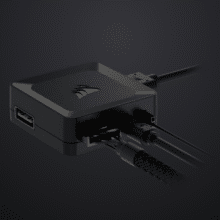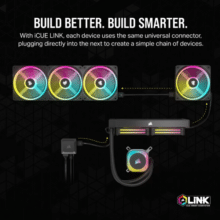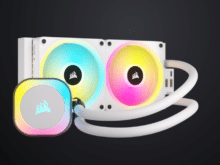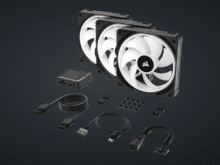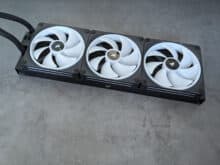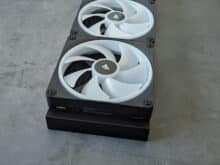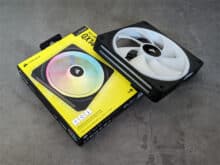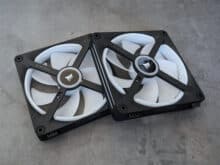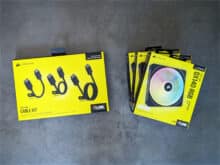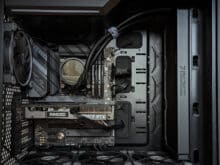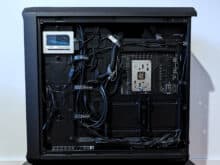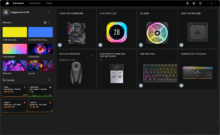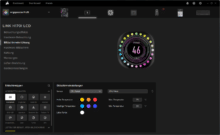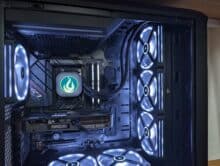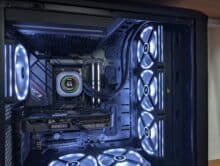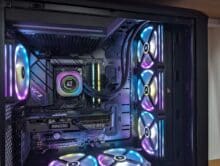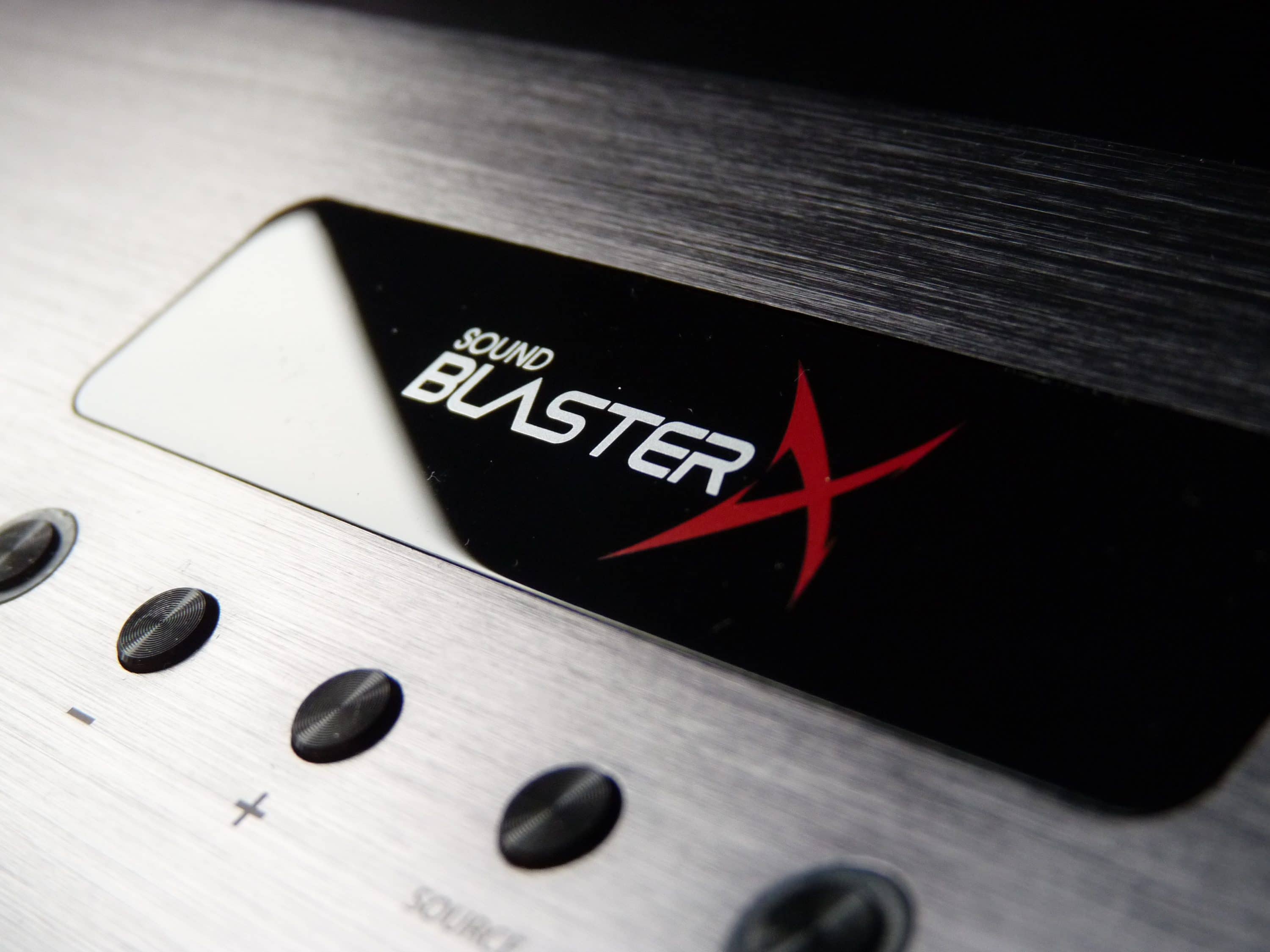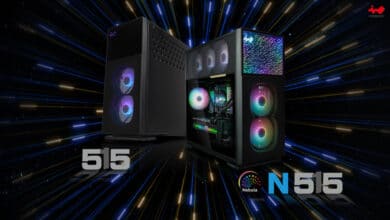
In times of cases with ten or more fans and eye-catching RGB lighting, clean cabling is becoming increasingly difficult. Each fan requires an ARGB cable and a fan cable, plus often splitter cables or extensions. Corsair iCUE LINK is designed to simplify this and significantly reduce the number of cables required. In the following, we take a closer look at the iCUE LINK ecosystem, the available iCUE LINK components, their cabling and control. For our test, we have the black model of the Corsair iCUE LINK H170i LCD AiO water cooling system (bundle with LCD screen module), iCUE LINK QX140 RGB fans and various cables at our disposal.
Corsair iCUE LINK: Overview
Corsair iCUE LINK is designed to simplify the cabling of individual components. The iCUE LINK components are connected in series with a single cable that transmits data and power, or a connector, and connected to the system hub, which is the control center of the system and is always necessary. Microcontrollers allow the iCUE LINK components to communicate with the system hub and be controlled individually.
The system hub measures 52 x 52 x 18 mm and is included with the iCUE LINK AiO water cooling and fan starter kits. It is also available separately for €57.90 (link to manufacturer).
The system hub is supplied with up to 168 W via a 6-pin Micro-Fit connector (connector B) and a 6-pin PCIe connector. Up to 7 components can be connected and supplied with power per iCUE LINK connection (connection A), making a total of up to 14 components. The data is transferred via a micro USB port (port C) and the 9-pin USB 2.0 connector on the mainboard. Furthermore, when using an iCUE LINK CPU cooler, the speedometer output (connection D) is connected to the CPU_FAN connection.
Corsair iCUE LINK: Available products and prices
The Corsair iCUE LINK Smart Component ecosystem (link to manufacturer) currently includes AiO water cooling systems, CPU and GPU water coolers, pump/expansion tank combinations, RGB fans and various cables. In addition to individual products, bundles and starter kits are also available.
AiO water cooling systems
The AiO water cooling systems are available in the radiator sizes 240 (H100i), 280 (H115i), 360 (H150i) and 420 mm (H170i) in the colors black and white (only H100i and H150i). The AiOs can also be supplemented with an LCD screen module, which is also available in black and white (also as a bundle). A system hub is included with all AiOs.
The recommended retail prices range from €242 for the iCUE LINK H100i to €323 for the H170i (link to manufacturer). This represents an increase of ~20 € compared to the iCUE ELITE CAPELLIX XT AiO water cooling systems.
RGB fan
Corsair offers the iCUE LINK RGB fans in the sizes 120 (QX120) and 140 mm (QX140) in the colors black and white. The fans have a total of 34 RGB LEDs and a temperature sensor.
The recommended retail price is €50 for an iCUE LINK QX120 RGB fan (link to manufacturer) and €55 for a QX140 RGB fan (link to manufacturer). The fans are also available as a starter kit for €160 (three QX120) or €121 (two QX140) with a system hub.
Cables and distributors
The components are connected to each other and to the system hub using iCUE LINK cables. The cables have an anti-twist plug and are available in lengths of 100, 135, 200 or 600 mm in black and white. The cable connections can also be straight, angled on one side or on both sides (135 mm only). Connectors, cable kits and a 4-way signal distributor are also available. The recommended retail prices range from €8 for a single 100 mm cable to €35 for a cable kit.

Corsair iCUE LINK in practical test
We were provided with the following iCUE LINK components in black for the test:
- Corsair iCUE LINK H170i LCD
- Corsair iCUE LINK QX140 RGB (3x)
- Corsair iCUE LINK Cable Kit
- Corsair iCUE LINK cable 1 × 90° 600 mm
The Corsair iCUE LINK H170i LCD uses a 420 mm radiator and three iCUE LINK QX140 RGB radiator fans. The highlight of the AiO water cooling system is the round 2.1″ IPS LCD screen located on the top of the pump. The pump housing itself is predominantly milky to light gray and is illuminated by RGB LEDs. The system hub is also included in the scope of delivery.
The Corsair iCUE LINK QX140 RGB fans have black fan frames and transparent light gray fan blades. The speed range of the 140 mm fans extends from 400 – 2,000 rpm, and the fans can also be switched off completely at low loads (Zero RPM mode). In the test, they could not be heard from the closed housing up to 700 rpm. There are a total of 34 RGB LEDs on the front and rear as well as on two sides of the frame, which can be controlled individually. The iCUE LINK connections are located on the other two sides of the frame. The temperature sensor is integrated into a strut of the fan frame. The individual fans are supplied with a 135 mm iCUE LINK cable, connectors and screws.
The Corsair iCUE LINK cable kit includes one 600 mm long, two 200 mm long and two 100 mm long iCUE LINK cables. All cables have straight connectors, cables with angled connectors are currently only available individually.
Test system
The test system was previously cooled by an ASUS ROG Ryuo III 360 ARGB AiO water cooling system (test) and 4 140 mm RGB fans and required 14 cables for the 7 RGB fans, 2 ARGB splitters, a fan splitter, a cable for the display and another cable for the pump of the AiO.
- ASUS ROG Strix B650E-F Gaming WiFi motherboard
- AMD Ryzen 7 7800X3D processor
- 32 GB Corsair Dominator Titanium DDR5 6000 MT/s CL30 RAM
- INNO3D GeForce RTX 3060 Twin X2 graphics card
- Crucial T700 2 TB SSD
- Crucial T500 2 TB SSD
- Crucial MX500 4 TB SSD
- Seasonic Focus GX-550 power supply
- Fractal Design Torrent Black TG Dark Tint
Assembly and cabling
We installed the Corsair iCUE LINK H170i LCD with its three QX140 RGB fans in the front, two QX140 RGB fans in the base and one QX140 RGB fan in the rear of the case. We attached the system hub behind the mainboard instead of the hard disk holder. There are magnets in the system hub, but as these are rather weak, we attached it with the enclosed double-sided adhesive tape. The three radiator fans and the two fans in the base are connected via a plug connection, and there are also magnets in the frame of the fans. The following connections are also required:
- System hub with a 6-pin PCIe power cable and a USB 2.0 header of the mainboard
- System hub with the CPU fan header of the mainboard (required for AiO water cooling)
- USB-C connection of the AiO water cooling with a USB 2.0 header of the mainboard (required for LCD display module, splitter included)
- first connection of the system hub with the first connection of the radiator via iCUE LINK cable
- second connection of the radiator with the first radiator fan
- second connection of the system hub with the fans in the base via iCUE LINK cable
- Fan in the base with the fan in the rear via iCUE LINK cable
Alternatively, the fans in the rear and the base could also be connected to the last radiator fan.
Before and after comparison of the cabling
In the following table we compare the number of cables. For a better comparison, we have calculated with 3 instead of 4 140 mm RGB fans as case fans in the previous system, as we could only install 2 RGB fans at the bottom due to the larger radiator (420 instead of 360 mm). The number of fans is therefore the same in both systems.
| System | Cables | Number of cables |
| Standard
(ARGB and speed individually) |
ARGB 1st AiO fan | 17 |
| Speed 1st AiO fan | ||
| ARGB 2nd AiO fan | ||
| Speed 2nd AiO fan | ||
| ARGB 3rd AiO fan | ||
| Speed 3rd AiO fan | ||
| ARGB splitter AiO fan | ||
| Speed splitter AiO fan | ||
| Speed AiO pump | ||
| USB cable AiO display | ||
| ARGB 1st housing fan | ||
| Speed 1st housing fan | ||
| ARGB 2nd housing fan | ||
| Speed 2nd housing fan | ||
| ARGB 3rd housing fan | ||
| Speed 3rd housing fan | ||
| ARGB splitter case fan | ||
| Corsair iCUE LINK | 6-pin PCIe power cable | 9 |
| Micro USB cable | ||
| USB-C cable (AiO display) | ||
| USB splitter cable | ||
| Speedometer cable (AiO) | ||
| LINK cable hub – bottom | ||
| LINK cable bottom – rear | ||
| LINK cable hub – AiO | ||
| LINK cable AiO – AiO fan |
Corsair iCUE LINK reduced the number of cables in the test system from 17 to just 9. Connecting the components is very quick and easy. As the iCUE LINK cables are somewhat thicker and also very stiff, interested parties should plan carefully which cables and which connections (straight or angled) they require. The straight iCUE LINK connection requires about 4 cm (with bending of the cable), the angled 1 cm starting from the fan frame.
Control
The iCUE LINK components are controlled via Corsair’s iCUE software, which automatically recognizes the connected devices. The individual fans can be differentiated using the wizard, which illuminates each fan differently.
The lighting of the iCUE LINK components can be extensively customized via the sub-item Lighting effects. There is a wide range of effects to choose from and the colors, speed and direction can be adjusted. Each RGB LED can also be adjusted separately. Furthermore, owners of an AiO water cooling system with LCD screen module can choose from ten different screen types that display the load or temperatures of the various components.
The fans, coolers (or pumps), their speed and profile as well as the data from the temperature sensors are displayed via the Cooling sub-item. The speed of the fans can be adjusted with fixed values, but also with a temperature or load curve; several profiles are already available for selection. The speed of the pump of the AiO water cooling systems, on the other hand, cannot be adjusted manually; the available profiles range from quiet (2,400 rpm) to intensive (2,800 rpm).
Corsair iCUE LINK test: Conclusion
Corsair iCUE LINK proved to be very practical in the test and was able to significantly reduce the number of cables required in our system. After connecting the system hub, the individual components are connected to each other in series, and there are connectors for adjacent fans. Thanks to microcontrollers in the components, they can still be controlled individually. They are controlled using Corsair’s iCUE software, which offers extensive customization options for fan control and, above all, for the ARGB lighting.
ICUE LINK offers particular advantages if you install many iCUE LINK components, e.g. an AiO water cooling system and case fans. If you also install fans from other manufacturers, for example, the advantage of cabling is somewhat negated. If you do, then you should consistently rely on iCUE LINK and must also keep this in mind when making new purchases. In addition to this limitation, the price is another disadvantage. The iCUE LINK components currently available, especially the fans and cables, are very expensive. It remains to be seen whether cheaper components for the masses will follow.
Corsair iCUE LINK
Design
Workmanship
Assembly
Hardware
Value for money
90/100
The iCUE LINK components provided impress with their appearance, workmanship and functions. The cabling is significantly simplified. However, the surcharge for iCUE LINK is very high.


